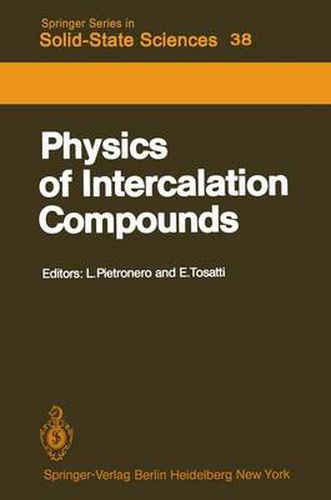Readings Newsletter
Become a Readings Member to make your shopping experience even easier.
Sign in or sign up for free!
You’re not far away from qualifying for FREE standard shipping within Australia
You’ve qualified for FREE standard shipping within Australia
The cart is loading…






This title is printed to order. This book may have been self-published. If so, we cannot guarantee the quality of the content. In the main most books will have gone through the editing process however some may not. We therefore suggest that you be aware of this before ordering this book. If in doubt check either the author or publisher’s details as we are unable to accept any returns unless they are faulty. Please contact us if you have any questions.
When an area of research is in fast growth, it often happens that no one single journal is to be found where most of the relevant publications are contained. Such is the case of the physics of intercalation compounds, a field which, by sitting at a corner point between materials science, solid state physics, and chemistry, finds its contributions largely scattered about in the literature. Given these circumstances it is of crucial interest to find a place where the most recent contributions and up-to-date referen ces can be found at once. For intercalated graphite and other similar com pounds this role has been played so far by proceedings of international con ferences, such as La Napoule (1977), Nijmegen (1979), Provincetown (1980), and Sendai (1980). The present book is an ideal continuation of this series, as it contains most of the invited and contributed papers of the Trieste International Con ference on the Physics of Intercalation Compounds, held in Trieste, Italy during the week 6-10 July 1981. The main emphasis is on intercalated graphite, though several interesting contributions deal with other materials, such as polyacetylene and transition metal compounds, or with general problems, such as two-dimensional melting. The book is divided into six sections-Structure and General Properties, Electronic Porperties, Stability and Phonons, Ordering and Phase Transitions, Magnetic Resonance, and Transport Properties-reflecting the main areas of interest, and also broadly the main discussion sessions of the Conference.
$9.00 standard shipping within Australia
FREE standard shipping within Australia for orders over $100.00
Express & International shipping calculated at checkout
This title is printed to order. This book may have been self-published. If so, we cannot guarantee the quality of the content. In the main most books will have gone through the editing process however some may not. We therefore suggest that you be aware of this before ordering this book. If in doubt check either the author or publisher’s details as we are unable to accept any returns unless they are faulty. Please contact us if you have any questions.
When an area of research is in fast growth, it often happens that no one single journal is to be found where most of the relevant publications are contained. Such is the case of the physics of intercalation compounds, a field which, by sitting at a corner point between materials science, solid state physics, and chemistry, finds its contributions largely scattered about in the literature. Given these circumstances it is of crucial interest to find a place where the most recent contributions and up-to-date referen ces can be found at once. For intercalated graphite and other similar com pounds this role has been played so far by proceedings of international con ferences, such as La Napoule (1977), Nijmegen (1979), Provincetown (1980), and Sendai (1980). The present book is an ideal continuation of this series, as it contains most of the invited and contributed papers of the Trieste International Con ference on the Physics of Intercalation Compounds, held in Trieste, Italy during the week 6-10 July 1981. The main emphasis is on intercalated graphite, though several interesting contributions deal with other materials, such as polyacetylene and transition metal compounds, or with general problems, such as two-dimensional melting. The book is divided into six sections-Structure and General Properties, Electronic Porperties, Stability and Phonons, Ordering and Phase Transitions, Magnetic Resonance, and Transport Properties-reflecting the main areas of interest, and also broadly the main discussion sessions of the Conference.